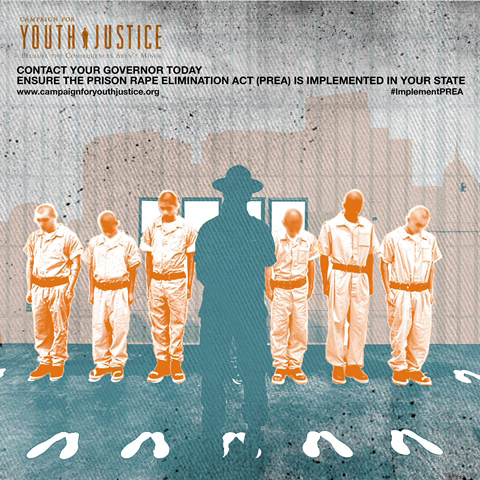Prison Rape Elimination Act
No Excuses: It's Time To Implement the Prison Rape Elimination Act
Please Urge Your State to Comply with the Prison Rape Elimination Act – The Safety of our Youth Depends on it

What is PREA?
The Prison Rape Elimination Act (PREA) is a federal statute focused on sexual assault and victimization in juvenile facilities, prisons, jail, lockups, and other detention facilities. The goal of PREA is to prevent, detect, and respond to sexual abuse in detention and correctional facilities.
Who is affected and why is this important?
An estimated 4.4% of prison inmates and 3.1% of jail inmates reported experiencing one or more incidents of sexual victimization by another inmate or facility staff in a 12 month period. Nationwide, these percentages suggest that approximately 88,500 adults held in prisons and jails had been sexually victimized in a one year time period.[i]
Even though only 1%[ii] of all jail inmates were youth under 18 in 2005 and 2006, they accounted for 21% and 13% of the victims of inmate-on-inmate sexual violence in jails respectively.[iii]
To “protect” the youth in adult facilities, some jails and prisons keep youth in solitary isolation for upwards of 23 hours a day.
Due to the extreme conditions of confinement and exposure to adult jails and prisons, youth have the highest suicide rates of all inmates in jails
Youth are 19 times more likely to commit suicide in jail than their counterparts in the general population and 36 times more likely to commit suicide in an adult jail than in a juvenile detention facility.[iv]
In a recent BJS study, two-thirds of youth ages 16 and 17 in adult jails and prisons who had been victimized reported being victimized more than once by other inmatesand three-quarters were victimized by staff more than once.
No Excuses
Jails and prisons are simply not equipped to protect youth from the dangers of adult jails and prisons. PREA recognizes the inherent dangers of placing youth in adult facilities therefore the PREA Youth Inmate Standard (§115.14) requires that:
The youthful inmate standard requires agencies must do their best in order to avoid placing youth in isolation to comply with this provision and must give youth daily large-muscle exercise and any legally required special education services, and must provide them access to other programs and work opportunities to the extent possible.
No youth under 18 can be placed in a housing unit where contact will occur with adult inmates in a common space, shower area, or sleeping quarters.
Outside of housing units, agencies must either maintain ‘‘sight and sound separation’’—i.e., preventing adult inmates from seeing or communicating with youth—or provide direct staff supervision when the two are together.
The PREA Resource Center Recommends that:
States change the policies or laws in order to reduce the number of youthful offenders housed in adult facilities.[v]
States make agreements with youth facilities in order to house youthful inmates in juvenile facilities.[vi]
[i] Beck, A.J., Harrison, P.M., Berzofsky, M., Casper, R., Krebs, C. (2010, August). Sexual Victimization in Prisons and Jails Reported by Inmates, 2008-2009. Washington, D.C.: U.S. Department of Justice, Office of Justice Programs, Bureau of Justice Statistics.
[ii] Snyder, H.N., Sickmund, M. (2006). Juvenile Offenders and Victims: 2006 National Report. Washington, D.C.: U.S. Department of Justice, Office of Justice Programs, Office of Juvenile Justice and Delinquency Prevention.
[iii] Beck, A.J., Harrison, P.M., Adams, D.B. (2007, August). Sexual Violence Reported by Correctional Authorities, 2006. Washington, D.C.: U.S. Department of Justice, Office of Justice Programs, Bureau of Justice Statistics.
Beck, A.J., Harrison, P.M., (2006, July). Sexual Violence Reported by Correctional Authorities, 2005. Washington, D.C.: U.S. Department of Justice, Office of Justice Programs, Bureau of Justice Statistics.
[iv]Calculations by comparing suicide rates published by the Bureau of Justice Statistics and the Centers for Disease Control. Mumola, C.J. (2005, August). Suicide and Homicide in State Prisons and Local Jails. Washington, D.C.: U.S. Department of Justice, Office of Justice Programs, Bureau of Justice Statistics.
[v] National PREA Resource Center (2013). Youthful Inmate Implementation.
[vi] National PREA Resource Center (2013). Youthful Inmate Implementation.
Take Action Now
Click here to sign our petition to the National Sheriffs' Association.
PREA Media Materials
- CFYJ Fact Sheet
- CFYJ Infographic (download here)
Additional PREA Resources:
PREA Panel with the American Bar Association:
On September 24, 2013, CFYJ along with the American Bar Association hosted a panel to commemorate the 10th anniversary of PREA becoming law, "Protecting the Incarcerated Client from Sexual Violence under the Prison Rape Elimination Act".
The observance featured a panel of experts that discussed DOJ standards and regulations designed to prevent victimization, ways to ensure states are implementing the regulations, as well as discussed tools to address prison rape and victimization. Panelists included: Hon. Bobby Scott, United States House of Representatives; Hon. Reggie Walton, United States District Court for the District of Columbia; Professor Brenda Smith, American University, Washington College of Law; T.J. Parsell, Author, Filmmaker and Human Rights Activist; Mary Lou Leary, and Principal Deputy Assistant Attorney General, Department of Justice, Office of Justice Programs.
Video highlights of the panel can be found here.

Statements from Members of Congress Commemorating 10 year Anniversary
PREA Case Profiles
- Case Profile- Antonio Beale
- Case Profile- Andrew Bibaud
- Case Profile- Jonathan Sawyer
- Case Profile- Burt Smith
- Case Profile- Ameen Thomas
Background Materials on PREA
- DOJ federal register notice with proposed regulations implementing PREA (Comments were due April 4, 2011)
- DOJ federal register notice on NPREC standards (Comments were due May 10, 2010)
- National Prison Rape Elimination Commission Report - June 2009
National Sign on Letters in Support of the Implementation of PREA
Letter to Attorney General (2013)

